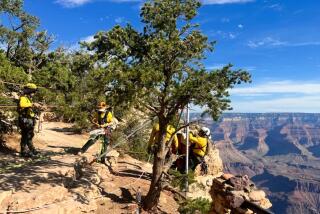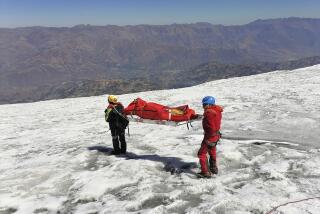Premier Rock Climber Falls to His Death in Yosemite : Accident: Derek Hersey was a free-soloist, using no ropes or equipment. A friend says he may have encountered moisture and slipped on Sentinel Rock.
- Share via
In the adrenaline-stoked realm of vertical rock climbing, Derek Geoffrey Hersey was regarded as one of the world’s best, a daredevil among daredevils who did not use a rope.
But for reasons that authorities said Sunday may never be known, the 36-year-old Hersey plunged to his death from the granite face of Yosemite National Park’s Sentinel Rock. A native of Manchester, England, Hersey for the past decade had lived in Boulder, Colo.
His body was recovered from a ledge at the base of the route he had chosen on 7,000-foot Sentinel Rock. Searchers from the National Park Service said Hersey was dead when they reached him at 11:30 a.m. Saturday, about 850 feet above the floor of Yosemite Valley.
Of the hundreds of climbers who scale the rock walls of Yosemite, Hersey was the first this year to die doing it. Five climbers died in 1992 and three died in 1991, according to a Park Service spokeswoman.
Hersey was one of the very few people who climbed alone--without ropes or any other technical equipment. Known as free-solo climbing, the sport is similar to walking a tightrope without a net. A November, 1991, New York Times Magazine article termed Hersey “one of the world’s great extreme free-solo climbers.”
When Hersey set out for Sentinel Rock on Friday, he wore rubber-soled climbing shoes, a black sweater and black pants. The only paraphernalia he carried was chalk, to dry the sweat from his hands, said Craig Luebben, a friend who drove with Hersey to Yosemite last week from Colorado and who reported him missing when he did not return to their campsite.
As those who have watched and photographed him attested Sunday, Hersey’s tools were his wiry strength and his singular concentration.
“Derek is one of the best solo climbers in the world,” Luebben said. “Very strong, excellent technique and excellent mind control.”
Luebben, also an experienced climber, speculated that Hersey slipped after encountering moisture on the smooth, polished face of Sentinel Rock.
He described the route Hersey chose as “close to vertical . . . strenuous, but moderate for someone of his level.”
Lisa Dapprich, a spokeswoman for the Park Service, said that although there were some clouds in the valley area Friday, there was no rainfall.
Dan Hare, manager of a mountaineering shop in Boulder, said Hersey was gifted, but “he tended to push the envelope a little bit, on a constant basis.”
“Probably less than five climbers in this country were climbing at Derek’s level, without a rope,” said Hare, who has photographed Hersey and who a few weeks ago sold him chalk. “It’s pretty much an adrenaline sport. There are people on the wild end, like Derek.”
Friends called Hersey a free spirit who partied as determinedly as he climbed.
“He probably has more friends in the climbing community than anyone I can think of,” Luebben said in a telephone interview. “He’s beloved in two countries.”
Authorities said they delayed releasing Hersey’s identity until Sunday in an effort to first inform his parents in England. Hersey also is survived by his girlfriend, Annie Whitehouse, a climber well known in Boulder. Luebben said she was on a trek in Tibet.
Hersey, a professional who was paid through commercial sponsorships, described the lure of his work in the New York Times article:
“(Observers) think you’ve got a death wish. But there’s nothing else that makes me feel so alive. . . . When you’re free-soloing, you can’t afford to be distracted. You concentrate on the flow from move to move to move. You exist only in the present.”
More to Read
Sign up for The Wild
We’ll help you find the best places to hike, bike and run, as well as the perfect silent spots for meditation and yoga.
You may occasionally receive promotional content from the Los Angeles Times.







